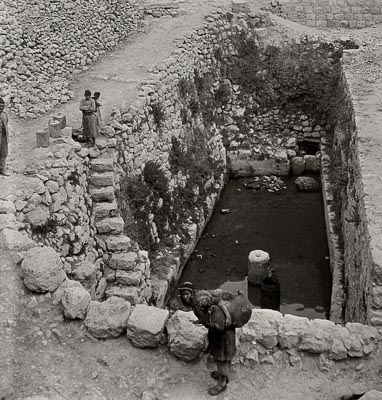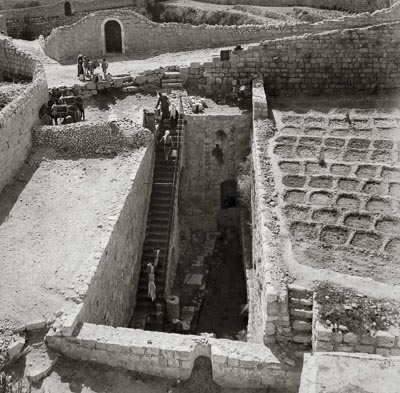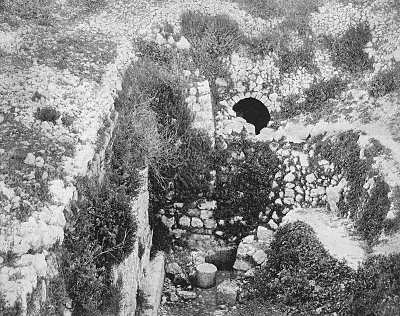
The Pool of Siloam

Source: American Colony: Jerusalem
Pool of Siloam
No water about Jerusalem has obtained such a wide celebrity as “Siloa’s brook, that flowed “Fast by the oracle of God.” Yet it is only thrice mentioned in the Bible. Isaiah speaks of “the waters of Shiloah that go softly;” Nehemiah tells us that Shallum built “the wall of the pool of Siloah by the king’s garden;” and then, most interesting of all, we have our Lord’s command to the blind man, “Go, wash in the pool of Siloam. He went his way therefore, and washed, and came seeing.” Josephus describes its position so clearly as to leave no doubt regarding its identity. (Source: Jerusalem, Bethany, and Bethlehem, p. 94.)
The Upper Pool of Siloam

Source: American Colony: Jerusalem
The only true spring known to exist in Jerusalem at the present day is the “Fountain of the Virgin.” . . . The water is conveyed from the spring to the Upper Pool of Siloam . . . by a passage cut in the rock, and thence runs down to irrigate some gardens. Its taste is slightly salt and decidedly unpleasant, owing chiefly to the fact that the water has filtered through the mass of rubbish and filth on which the city stands. This peculiarity in the taste is intensified at Siloam, as the water passes over a slimy deposit, from two to three inches deep, which covers the bottom of the passage. The people make matters worse by bathing and washing their clothes in the same place from which they draw water for drinking purposes. The passage between the spring and the Upper Pool of Siloam is seventeen hundred feet long, about two feet wide, and from one foot ten inches to sixteen feet in height. (Source: Picturesque Palestine, vol. 1, pp. 102-104.)

Source: Earthly Footsteps of the Man of Galilee, p. 227.
Pool of Siloam
"There is nothing picturesque about it, certainly. The crumbling walls, and fallen columns in and around it, give it an air of neglect." It is a parallelogram about fifty-three feet long and eighteen feet wide. . . . Dr. Thomson says he has seen this pool nearly full, but that now the water merely passes through it. Rev. H. B. Hackett writes of its outflow: "A streamlet murmurs gently along sparkling in the sunbeams." . . . The name Siloam, according to Gesenius, signifies "sent," with the meaning of artificial direction through an aqueduct. . . . Siloam is a remitting fountain, being suddenly augmented at irregular intervals. "The intermittent flow is supposed to be due to a natural syphon, but the natives' explanation is that a dragon lives below and swallows the water when he is awake, but that when he sleeps it wells up freely."--Major Conder. (Source: Earthly Footsteps of the Man of Galilee, p. 227.)
See Water Systems in Jerusalem, the Pool of Siloam, the Pools of Solomon, or Water in Egypt
At BiblePlaces, see Warren's Shaft, The Pool of Siloam, or Hezekiah's Tunnel